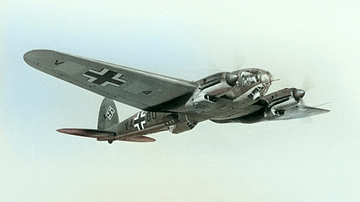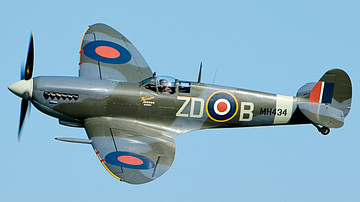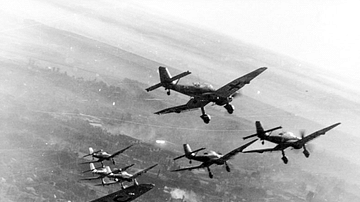
The Messerschmitt Bf 109, also known as the Me 109, was Germany's most important single-seater fighter plane throughout the Second World War (1939-45). Produced in greater numbers than any other German plane, the fighter was a match for the RAF's Supermarine Spitfire in the Battle of Britain and was employed on a range of fronts from North Africa to Russia.
Design
The Messerschmitt Bf 109 was the second monoplane design of Wilhelm ("Willy") Messerschmitt (1898-1978). The "Bf" refers to the Bayerische Flugzeugwerke company, which made the planes and where Messerschmitt was the chief designer. In the mid-1930s, a single-seater fighter project was set up by the German government to find the best possible design for an airplane that would become one of the most important aircraft of the Luftwaffe (the German airforce). Also known as the Me 109, Messerschmitt's design won the contract, beating other established manufacturers like Arado, Focke-Wulf, and Heinkel. The latter company did impress with its Heinkel 112, and so the state ordered ten prototypes of this plane as well as ten of the Me 109.
The prototype Me 109s had British Rolls-Royce engines and the plane impressed at trials in Augsburg in September 1935. The first production models had a Junkers Jumo 210A engine. The German public got its first view of the Me 109 in a procession at the Berlin Olympic Games in the summer of 1936. In the spring of 1937, the first planes were operational. The Jumo engine was upgraded several times, and the aircraft saw their first military action in the Spanish Civil War (1936-9). Willy Messerschmitt took over the Bayerische Flugzeugwerke in July 1938 as Germany geared up its armaments manufacturing ready for war. The company was renamed Messerschmitt AG, and by September around 600 of the fighters had been built. Some planes had a superior Daimler-Benz engine fitted early on, and by 1939, this became the standard. By the end of 1939, the Luftwaffe had some 2,000 Me 109s at its disposal. By 1940, over 150 of the fighters were rolling off the production line each month. The plane was continually developed throughout the war in attempts to increase performance, stability, and firepower. In total, some 35,000 Me 109s were built.
A two-seater version of the Me 109, the Bf 109G-12, was used for training purposes. Besides the Luftwaffe, the fighter plane was flown by the air forces of Italy, Switzerland, Spain, Bulgaria, Croatia, Finland, and Hungary, amongst others.
Specifications & Armaments
The Me 109 had a length of 9.02 m (29 ft 7 in) and a wingspan of 9.92 m (32 ft 6.5 in). It was powered by a Daimler-Benz DB 605 AM 12-cylinder engine capable of 1100 kW (1,475 hp), although some later versions increased this power by a third. The top speed was around 610 km/h (385 mph) with a maximum ceiling of 11,550 m (37,895 ft), although the specialised Bf 109H could fly up to 14,480 m (47,500 ft). The usual range was around 600 km (370 mi), but this could be extended to 1000 km (620 mi) with the addition of an extra fuel tank.
The fighter was armed with a cannon (which fired through the propeller shaft) and two machine guns situated above the engine, and so they fired through the propeller arc. The cannon could have a calibre of 20 mm or 30 mm (0.79 in or 1.18 in). The machine guns were 13-mm (0.51 in) MG 131s and were provided with at first 500 rounds and then, in later models, 1,000 rounds of ammunition each. The ammunition load was a significant advantage over its main rival, the British Supermarine Spitfire. The Spitfire's pilot could fire his machine guns only for around 15 seconds in total, while the Me 109 pilot had up to 55 seconds (although both sets of pilots usually fired in short 2-3 second spells). The cannon had 60 rounds of ammunition and could be fired separately from the machine guns. A single cannon shell could do a great deal of damage. One Royal Air Force (RAF) pilot described a Spitfire he was flying alongside being subjected to a Me 109's cannon fire: "The cockpit blew up. You could see the canopy disappear and presumably the bloke as well because there was such an explosion" (Holland, 684). Extra armaments could include fitting an additional cannon beneath each wing. The fighter could also carry a total maximum bomb weight of 250 kg (551 lb) – either in the form of a single bomb or four 50-kg (110 lb) bombs.
The Me 109 was used in many theatres of war, and so it could have a wide array of camouflage schemes, for example, with a light-coloured undercarriage and dark green or mottled grey top (Europe), yellow with dark spots (desert), and mostly white (Scandinavia), amongst others. In the Battle of Britain in the summer of 1940, Me 109s often had painted yellow engine covers, tail tips, and wing tips to aid identification in skies that became saturated with fighter planes.
Operations & Tactics
Me 109s, known to their pilots as "Emils", were used from the very beginning of World War II as the German blitzkrieg tactics (fast-moving armour and planes combined) swept Germany through its European neighbours. Once the new territory was occupied, the fighter had three key roles: establish air superiority over the front line to a depth of 50 km (30 mi), defend bomber formations, and defend key strategic sites like heavy industry. A fourth role was occasionally performed when the fighter was fitted with a bomb load and used to attack small strategic targets like radar stations.
When the Luftwaffe established itself at new airfields in northern France and Belgium, it then became possible for Me 109s to give fighter cover to bomber missions over Britain. During the Battle of Britain, the Me 109E was the only singe-seater fighter employed by the Luftwaffe. The battle was closely fought and became one of attrition. At first, the Me 109 proved a winner against the RAF's best fighters, especially above 6,000 m (20,000 ft) where "its faster climb rate, higher combat ceiling, heavier armament, and better diving capabilities proved decisive" (Dildy, 43).
The speed and manoeuvrability of the Me 109 were certainly superior to the Hawker Hurricane, the most numerous fighter in the RAF. However, the RAF's second fighter, the Supermarine Spitfire, easily matched the German fighter after it went through several design improvements. The Spitfire perhaps had better overall manoeuvrability and stability, but the Me 109 had an advantage in its fuel injection system, which allowed pilots to dive with less chance of stalling. Naturally, these performance advantages on both sides very often depended on the individual and very varied skills of the pilots. Spitfire pilots certainly had better visibility through their perspex canopy while ME-109 pilots had their view impaired by the heavy metal framing of their canopies.
The German fighter pilots flew in much better tactical formations. Known as the Rotte, "two aircraft flew some 180 m (200 yd) apart. The main responsibility of the number two, or wingman, was to guard his leader from an attack from his quarter, or from behind, while the leader navigated his small force and also covered his wingman." (Dear, 281). This tactic developed into the Schwarme where there were always two pairs of fighters together. All four planes were relatively spread out, which made the group much less visible than the tighter RAF fighter formations. Those pilots who shot down a certain number of enemy planes became aces or Experten and eligible for highly-prized medals. As the Battle of Britain came to a close, Me 109s were again used as bombers, this time over London.
Despite the better formations of the Luftwaffe and the higher success rate of the Me 109 pilots against their British counterparts, a combination of factors ensured the RAF could not be beaten, and so German air superiority was not established. These factors included the enemy's effective use of radar, the RAF's continuous technical developments, the limited air time over Britain for German fighters, and the continued losses in bomber aircraft and fighters, losses which could not be replaced directly from France and Belgium (since repair factories were located only in Germany). Ultimately, the German high command changed tactics to heavy night bombing; the RAF had won the Battle of Britain.
Besides enemy fighters, the Me 109 pilots were tasked with shooting down enemy bombers as the air war became one where heavy bombing raids were the primary strategy. The Luftwaffe pilots soon found that attacking enemy bomber formations head-on brought better results. The tactic tended to force the bombers to break up their formation, and it meant that enemy fighters had less time to attack them. There were disadvantages, though, as Luftwaffe fighter pilot Major Werner Schröer explains:
Later on we tried to attack from the front, but you could only use experienced fighters for that because of the difficulty in escaping afterwards through the formation, because you had very little time to shoot, hit him and then escape.
(Holmes, 427)
Me 109s played a vital role in the success of Germany's Afrika Korps in the North Africa campaign. This was perhaps the theatre where coordination between the German army and airforce was at its best. Me 109s were used as fighter cover for bombers like the Junkers 88, which targeted British forces. Fighters were also used to defend German-held positions against British bombers. Me 109s, and the Luftwaffe in general, had less success on the Eastern Front when Soviet pilots and equipment improved through experience and their vastly superior numbers began to tell. The much greater distances involved on the Eastern Front was another telling factor for a fighter, even when fitted with extra fuel tanks, not known for its range.

Another vital use of Me 109s was the defence of Germany, especially against the large bomber raids conducted by the RAF and United States Air Force (USAAF) against strategic targets like armaments factories and large cities. In order to combat these attacks, many of which were 1,000-bomber raids, the Luftwaffe's fighters were reorganised tactically. The first approach, employed from mid-1940, was the Kammhuber Line and Raumnachtjagd systems, which had a single fighter plane stationed in a "box" in an imaginary grid across Northern Europe. The fighters circled within these "boxes" at night until given the direction of enemy aircraft by radar operators. The system worked well enough until the RAF used devices to jam the German radar systems during Operation Gomorrah (the raid on Hamburg in the summer of 1943). A new tactic was Wilde Sau ('Wild Boar'), which permitted fighters to fly freely above cities and attack enemy bombers at will. To ensure the fighters were not hit by their own anti-aircraft guns, the fighters patrolled above a pre-arranged altitude. Wilde Sau proved successful because the Allied bombers could be attacked from above when they were made more visible silhouetted against the fires of the targets they were bombing below.
Legacy
The Me 109 was outclassed by the Luftwaffe's Focke-Wulf 190, introduced from 1942, and even more so by the USAAF's P-51 Mustang, which could fly faster, further, and higher. As with the Eastern Front, the United States' far superior numbers and greater capability to make good on losses meant the Luftwaffe lost control of the skies over Western and Central Europe.
In the final year of the war, the Me 109 was further eclipsed by a new generation of jet-powered fighters, which included the Messerschmitt 262. Hitler negated the 262's jet-propelled advantages by insisting it be used as a bomber, and he only changed his mind when the war was already lost. Fighter warfare was about to be revolutionised, but the Me 109 had played its part both in the war and in preparing the foundations for the jet fighters that would dominate the Cold War.









